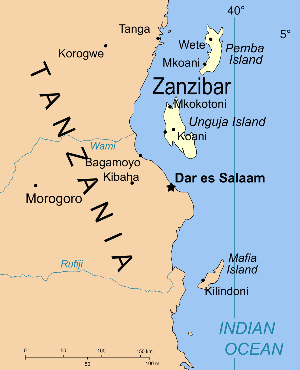
Zanzibar is an insular semi-autonomous province which united with Tanganyika in 1964 to form the United Republic of Tanzania. It is an archipelago in the Indian Ocean, 25–50 kilometres (16–31 mi) off the coast of the mainland, and consists of many small islands and two large ones: Unguja and Pemba Island. The capital is Zanzibar City, located on the island of Unguja. Its historic centre, Stone Town, is a World Heritage Site.

The Civic United Front is a liberal party in Tanzania. Although nationally based, most of the CUF's support comes from the Zanzibar islands of Unguja and Pemba. The party is a member of Liberal International.

Abeid Amani Karume was the first President of Zanzibar. He obtained this title as a result of a revolution which led to the deposing of Sir Jamshid bin Abdullah, the last reigning Sultan of Zanzibar, in January 1964. Three months later, the United Republic of Tanzania was founded, and Karume became the first Vice President of the United Republic with Julius Nyerere of Tanganyika as president of the new country. He was the father of Zanzibar's former president, Amani Abeid Karume.

The Anglo-Zanzibar War was a military conflict fought between the United Kingdom and the Zanzibar Sultanate on 27 August 1896. The conflict lasted between 38 and 45 minutes, marking it as the shortest recorded war in history. The immediate cause of the war was the death of the pro-British Sultan Hamad bin Thuwaini on 25 August 1896 and the subsequent succession of Sultan Khalid bin Barghash. The British authorities preferred Hamoud bin Mohammed, who was more favourable to British interests, as sultan. In the agreement of 14 June 1890 instituting a British protectorate over Zanzibar, a candidate for accession to the sultanate should obtain the permission of the British consul, and Khalid had not fulfilled this requirement. The British considered this a casus belli and sent an ultimatum to Khalid demanding that he order his forces to stand down and leave the palace. In response, Khalid called up his palace guard and barricaded himself inside the palace.

Seif Sharif Hamad was a Tanzanian politician who served as the First Vice President of Zanzibar and as Party Chairman of ACT Wazalendo. He was the secretary-general of the opposition Civic United Front (CUF) party and First Vice President of Zanzibar until 18 March 2019 when he announced his resignation from CUF and joined Alliance for Change and Transparency. He was given an ACT Wazalendo card number One, and he also won the party nomination for the 2020 presidential candidate for Zanzibar.

Amani Abeid Karume is a Tanzanian politician, the former president of Zanzibar. He held the office from 8 November 2000 to 3 November 2010. He is the son of Zanzibar's first president, Abeid Karume, and a member of the Chama Cha Mapinduzi (CCM) party.

The Zanzibar Revolution occurred in 1964 and led to the overthrow of the Sultan of Zanzibar and his mainly Arab government by local African revolutionaries. Zanzibar was an ethnically diverse state consisting of a number of islands off the east coast of Tanganyika, which had been granted independence by Britain in 1963. In a series of parliamentary elections preceding independence, the Arab minority succeeded in retaining the hold on power it had inherited from Zanzibar's former existence as an overseas territory of Oman. Frustrated by under-representation in Parliament despite winning 54 per cent of the vote in the July 1963 election, the African Afro-Shirazi Party (ASP) early in the morning of 12 January 1964, led by John Okello, the (ASP) youth leader of the Pemba branch, mobilised around 600–800 revolutionaries on the main island of Unguja whom he had mobilized months earlier. Having overrun the country's police force and appropriated their weaponry, the insurgents proceeded to Zanzibar Town, where they overthrew the Sultan and his government. Reprisals against Arab and South Asian civilians on the island followed; the resulting death toll is disputed, with estimates ranging from several hundred to 20,000. The moderate ASP leader Abeid Karume became the country's new president and head of state.
John Gideon Okello was a Ugandan revolutionary and the leader of the Zanzibar Revolution in 1964. This revolution overthrew Sultan Jamshid bin Abdullah and led to the proclamation of Zanzibar as a republic.
Abdulrahman Mohamed Babu was a Zanzibar-born Marxist and pan-Africanist nationalist who played an important role in the 1964 Zanzibar Revolution and served as a minister under Julius Nyerere after the island was merged with mainland Tanganyika to form Tanzania. He was jailed by Nyerere from 1972 and, after his release following an international campaign, remained a vocal critic of imperialism, authoritarian states and excessively statist development models.
People have lived in Zanzibar for 20,000 years. History properly starts when the islands became a base for traders voyaging between the African Great Lakes, the Somali Peninsula, the Arabian peninsula, Iran, and the Indian subcontinent. Unguja offered a protected and defensible harbor, so although the archipelago had few products of value, Omanis and Yemenis settled in what became Zanzibar City as a convenient point from which to trade with towns on the Swahili Coast. They established garrisons on the islands and built the first mosques in the African Great Lakes Region.

Operation Parthenon was a British plan for military intervention in Zanzibar following the 1964 revolution. The operation was authorised by the British Commanders Committee East Africa on 30 January. The main objectives were to restore law and order in Zanzibar and to prevent the radical left-wing Umma Party from taking control of the government from the moderate Afro-Shirazi Party. The forces assigned to the operation included two aircraft carriers, three destroyers, a Royal Fleet Auxiliary vessel, 13 helicopters, 21 transport or reconnaissance aircraft, a battalion of Foot Guards, a battalion of Royal Marines and an independent company of paratroopers. The plan was to launch a helicopter and parachute assault of Unguja, Zanzibar's main island, before proceeding to take the smaller island of Pemba. If it had been carried out, Parthenon would have been the largest British airborne and amphibious operation since the Suez Crisis of 1956. Parthenon was scrapped around the 20 February and replaced with Operation Boris.

Operation Boris was a British plan for military intervention in Zanzibar following the 1964 revolution. It was devised around 20 February to be used if the radical left-wing Umma Party attempted to take power. It replaced the earlier sea-based Operation Parthenon with a parachute assault launched from Kenya. However the operation was not required and was jeopardised by the lack of co-operation from the Kenyan government and populace for an attack on Zanzibar. Boris was replaced by Operation Finery, an amphibious helicopter assault, on 9 April 1964.

Operation Finery was a British plan for military intervention in Zanzibar following the 1964 revolution. It was a replacement for the earlier operations Parthenon and Boris, amphibious and airborne assaults. Finery circumvented the reliance of the previous plans on bases in Kenya, where government and local support for intervention were not forthcoming. Instead, Finery would have utilised the commando carrier HMS Bulwark to land Royal Marines on Zanzibar to protect Karume's government. Because of delays in the deployment of Bulwark, Finery was supplemented by Operation Shed, which could be launched at shorter notice. The expected coup did not occur, and Finery was scrapped on 29 April 1964, although Operation Shed remained in place.

Plan Giralda was a British plan for military intervention in Zanzibar following the 1964 revolution. Giralda was intended to be launched if the radical left-wing Umma Party attempted to launch a coup against the government of President Julius Nyerere's newly formed Tanzania. It was the fifth and final British plan for such an eventuality, following Operations Parthenon, Boris, Finery and Shed. Giralda would have required British Army units, Royal Marines and Royal Navy vessels from the Far East to be deployed to Zanzibar if a request was received from Nyerere. Follow on units would be sent after the main assault from the British garrison in Kenya. The operational constraints of sending troops over such long distances, the reluctance of the Kenyan government to weaken the British presence in their country, the reduction of Western presence in Zanzibar and the strengthening of the political situation in Tanzania made intervention unlikely and the plan was suspended in October 1964. The newly elected Labour government cancelled the plan in December.

The House of Wonders or Palace of Wonders is a landmark building in Stone Town, Zanzibar. It is the largest and tallest building of Stone Town and occupies a prominent place facing the Forodhani Gardens on the old town's seafront in Mizingani Road. It is located between the Old Fort and the Palace Museum. It is one of six palaces built by Barghash bin Said, second Sultan of Zanzibar, and it is said to be located on the site of the 17th-century palace of Zanzibari queen Fatuma. The House of Wonders housed the Museum of History and Culture of Zanzibar and the Swahili Coast.

The People's Republic of Zanzibar was an African state founded in 1964, consisting of the islands of the Zanzibar Archipelago. It existed for less than a year before it merged with Tanganyika to create the United Republic of Tanganyika and Zanzibar, which would be renamed to Tanzania in October of that year.
The following is a timeline of the history of Zanzibar City, Unguja island, Zanzibar, Tanzania. The city is composed of Ng'ambo and Stone Town. Until recently it was known as Zanzibar Town.
Zanzibari independence is a political ambition of some political parties, advocacy groups, and individuals of Zanzibar, a semi-autonomous region territory within Tanzania, to become an independent sovereign state.
East Germany–Zanzibar relations concerned historical foreign and bilateral relations between the German Democratic Republic and the People's Republic of Zanzibar, both of which are now former states. During the short existence of Zanzibar as an independent state, which emerged in the wake of the 1964 Zanzibar Revolution, East Germany was a key ally of the fledgling island state. East Germany initiated a number of assistance programs to Zanzibar, and established its first embassy in Africa on Zanzibar. Once Zanzibar entered into a union with Tanganyika, the issue of relations with East Germany became politically complex.










